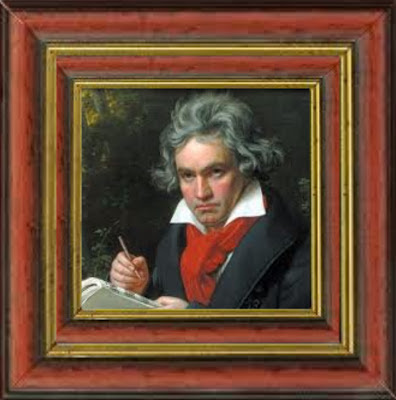The 5th Symphony of Beethoven with its familiar three short and one long note motif, is the most recognizable and popular pieces of music ever written. Beethoven premiered the work at a massive 4-hour concert in December in Vienna in 1808. due to the coldness of the theater and the fact that the symphony only had one rehearsal earlier in the day, there was not much critical input about the work. But a little over a year later the work was repeated to rave reviews. All through the 19th century it slowly became a cornerstone of symphonic repertoire, and has been one ever since.
Don't let the familiarity of the symphony cause a bias against it. There are wonders within it, way more than the famous 'fate knocking at the door' motif that begins the symphony. This motif acts as the raw material that is used to construct the first movement, and it makes an appearance throughout the entire work, albeit sometimes in altered form. This is a prime example of why I think Beethoven is the greatest composer of them all, in the sense of the word that means putting together a coherent composition from original material. His musical structures are solid, he was a total master of sonata form. Beethoven seems to have found his freedom of expression within the form itself. He would alter the form as his ideas dictated, but still kept the bare bones of the form. There are musicians and composers that had a greater gift for melody, some that were more brilliant at orchestration, some more daring harmonically. But for the total package, which includes being a master architect of musical form, no one outshines Beethoven.
The 5th Symphony is in 4 movements:
I. Allegro con brio - The famous opening that is the seed of the entire symphony catches the ear immediately. It is pregnant with drama and struggle, and is heard throughout the first movement as it keeps hammering home the sense of struggle. The movement is in sonata form, and Beethoven seems to have compressed and reduced the music into a pungent musical language that is given little relief. Even the short oboe near the end of the movement is full of pathos. The work hammers the motive home again, and it ends.
II. Second movement: Andante con moto - The second movement is a double variation, there are two melodies heard one after the other in the opening, then they are both varied in turn.
III. Third movement: Scherzo. Allegro - A Scherzo full of mystery and a repeat of the 'fate' motive of the first movement in the horns, as well as a fugal trio section. When the scherzo begins again after the trio Beethoven changes the orchestration ad dynamics and with the timpani gently beating out the note of 'c', the movement segues into the finale.
IV. Fourth movement: Allegro - The finale is also in sonata form, with the second theme repeating the 'fate' motive. Just as the orchestra really gets going, a rapid change happens and parts of the Scherzo reappear for a few bars until the finale themes return ablaze. The finale keeps hammering away with the chords of C Major having won the struggle and defeating the C minor triad, and the work ends triumphantly.
Modern listeners can really never appreciate how Beethoven's music sounded to his contemporary listeners. What has become common place ( if not outright cliché) was once very innovative and original. Some of the wonder of the music is no doubt lost on us, but one way to get an idea of the novelty and originality of it is to listen to it with ears that can take on an historical perspective.


No comments:
Post a Comment